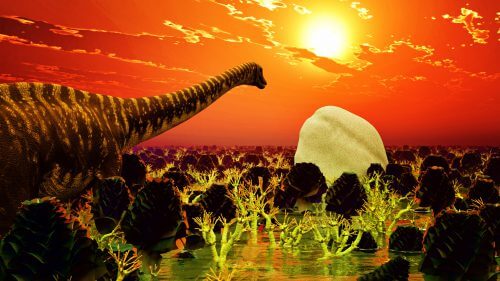Lead researcher Alessandro Chiarenza, a PhD student in the Department of Earth Sciences and Engineering at Imperial College, said: "Dinosaurs weren't supposed to go extinct until the end of the Cretaceous, when the asteroid hit ended their reign and left the planet to animals such as mammals, lizards and a small group of surviving dinosaurs. – the poultry.”

According to a new study by researchers from three universities in Great Britain, who studied the dinosaur finds in North America. Nor were they affected by long-term climate change before their sudden extinction.
Scientists largely agree that an asteroid impact, possibly with intense volcanic activity, wiped out the dinosaurs at the end of the Cretaceous period 66 million years ago. However, there was still debate as to whether dinosaurs were booming when the asteroid hit them or were in decline due to long-term climate change over millions of years or whether they were declining and the asteroid just dealt the final blow.
In the past, the researchers used the fossil record and mathematical predictions from which it appears that the dinosaurs were already in a state of decline in the number of species before the asteroid hit.
Now, in a new analysis that demonstrates the changing environment and distribution of dinosaur species in North America, researchers from Imperial College London, University College London and the University of Bristol have shown that dinosaurs were not in decline before the impact.
Lead researcher Alessandro Chiarenza, a PhD student in the Department of Earth Sciences and Engineering at Imperial College, said: "Dinosaurs weren't supposed to go extinct until the end of the Cretaceous, when the asteroid hit ended their reign and left the planet to animals such as mammals, lizards and a small group of surviving dinosaurs. – the poultry.”
"The results of our research show that dinosaurs as a whole were adaptive animals, able to cope with the environmental changes and climatic fluctuations that occurred during the last million years of the Late Cretaceous period. The prolonged non-climatic changes did not cause a decline in some dinosaur species in the last stages of this period."
The study, published in the journal Nature Communications, shows how the loss caused by climate change has been misinterpreted in previous studies.
The researchers focused on North America where the fossils of many dinosaurs from the Cretaceous period, such as Tyrannosaurus rex, and Triceratops were preserved. During this period, the continent was divided in two by a large inland sea.
In the western half of the North American continent, there was a constant supply of sediment from the New Rocky Mountains, which created perfect conditions for the preservation of fossilized dinosaurs after their death. The eastern half of the continent was characterized by less suitable conditions for conservation. This means that more dinosaur fossils were found on the western side of the continent. This suggests that the dinosaurs were in decline for several million years before the asteroid hit, because otherwise they would have been common in the East as well.
The author of the article Dr. Philip Mannion, from University College London, noted: "Most of what we know about the late dinosaurs of North America, comes from an area less than a third of the present continent, but we know that the dinosaurs roamed across North America, from Alaska to New Jersey and south to Mexico".
Instead of using only the known fossil record, the team used an 'ecological niche model'. This approach also adds to the models environmental conditions, such as temperature and rainfall, to which each species must adapt to survive.
The team then mapped where these conditions existed both across the continent and over time. This allowed them to create a picture in which they assessed which groups of dinosaur species might have survived the conditions and not just those whose fossils were found.
The team found that habitats that could support a variety of dinosaur groups were more common at the end of the Cretaceous, but these were found in areas less likely to preserve fossils.
Furthermore, the dinosaur-rich areas were smaller, again reducing the likelihood of finding fossils in any of these areas.
For the announcement on the Imperial College London website
More of the topic in Hayadan:
- The asteroid wiped out almost all the birds along with the dinosaurs
- The mammals almost went extinct with the dinosaurs
- Why did the dinosaurs become extinct?
- "We must prepare for the danger of an asteroid collision with the Earth, otherwise we will end up like the dinosaurs"
- Dinosaurs were warm blooded

One response
Just like the dinosaurs who in their brains may or may not have known that they were the center of the world and lived a life of happiness and prosperity, humans also do not know when their end will come. What will destroy us, it could be an asteroid or the end of the sun that feeds us or an all-out nuclear war that will lead to our destruction in any case, the human crowd thinks that he knows everything and the ego as if we are the center of the world will eventually lead to our destruction and we will not know it or we will be sorry because as we were another species will come after us